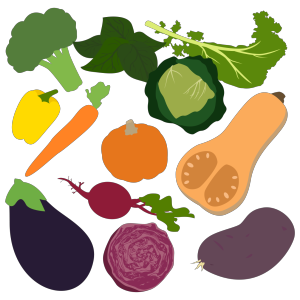Cooking by Color: A Vegetable Guide
 Sometimes you just want a little kitchen shortcut. Have you ever thought about cooking vegetables by color? It turns out that many vegetables that share colors also share other qualities that impact how they are cooked.Cooking Greens (High in Chlorophyll)Greens cook well in open pots — only cover if you want to briefly steam.Greens also tend to cook quickly, so watch them closely.You can cook greens with just a little water for maximum tenderness, but don’t add acids or the greens will discolor.That said, if you’re dying to use an acid, cooking the greens in an alkaline solution with baking soda maintains color, but it also destroys the thiamine and vitamin C content.Cooking Yellow, Orange and Red Vegetables (High in Carotenoids)Foods that are high in carotenoids are resistant to heat and sensitive to oxidation.Cook them quickly and use a little fat while you cook. This will help the vegetables retain their nutrients better than if you cook them in a huge pot of water that you discard. Steaming is an excellent choice too.Cooking Purple, Blue, and Red Vegetables (High in Flavonoids)When cooking foods that are violet or blue, adding an acid will turn them red. Cooking them in an alkaline solution will turn them blue.Red foods will generally stay red when an acid is added. For example, you can add vinegar when cooking beets and not impact their color.If you cook these foods in alkaline waters that contain valium and magnesium, then dark brown tannin complexes might develop. If this doesn’t look appetizing, add lemon juice. Lemon juice will lighten the food in this case.By Judy Doherty, PC IISources:
Sometimes you just want a little kitchen shortcut. Have you ever thought about cooking vegetables by color? It turns out that many vegetables that share colors also share other qualities that impact how they are cooked.Cooking Greens (High in Chlorophyll)Greens cook well in open pots — only cover if you want to briefly steam.Greens also tend to cook quickly, so watch them closely.You can cook greens with just a little water for maximum tenderness, but don’t add acids or the greens will discolor.That said, if you’re dying to use an acid, cooking the greens in an alkaline solution with baking soda maintains color, but it also destroys the thiamine and vitamin C content.Cooking Yellow, Orange and Red Vegetables (High in Carotenoids)Foods that are high in carotenoids are resistant to heat and sensitive to oxidation.Cook them quickly and use a little fat while you cook. This will help the vegetables retain their nutrients better than if you cook them in a huge pot of water that you discard. Steaming is an excellent choice too.Cooking Purple, Blue, and Red Vegetables (High in Flavonoids)When cooking foods that are violet or blue, adding an acid will turn them red. Cooking them in an alkaline solution will turn them blue.Red foods will generally stay red when an acid is added. For example, you can add vinegar when cooking beets and not impact their color.If you cook these foods in alkaline waters that contain valium and magnesium, then dark brown tannin complexes might develop. If this doesn’t look appetizing, add lemon juice. Lemon juice will lighten the food in this case.By Judy Doherty, PC IISources:
- Food Science, Norman Potter, Chapter 18, Vegetables and Fruit.
- Modernist Cooking, Nathan Myhrvold, Chris Young and Maxime Bilet, Chapter 3.
For more great cooking ideas, visit https://foodandhealth.com.